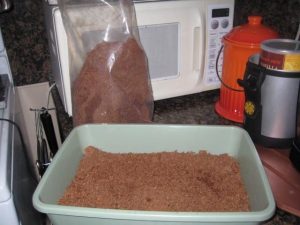This is a question I found myself asking last spring of unsuspecting strangers. Needless to say, it produced an awful lot of laughs, but, alas, no worms.
In my quest to live as green a life as possible, I made the decision to start vermicomposting. You may be wondering why someone would want to do this? What exactly are the benefits? As the worms consume the garbage, they produce castings. These castings can then be used as soil amendment for your garden or house plants. You can sprinkle a thin layer of worm castings on top the soil, or incorporate it into the soil. You can also make a “tea” out of the castings and water your plants with this nutrient-rich liquid.
Additionally, as of this writing, I no longer have garbage service. Instead, I return recyclable materials to a buy-back center and use my worm bin to dispose of decomposable materials. Just to make things more interesting, I have a dog. Before you can think the question, no, the pet waste does not go in the worm bin. There is a special composter for pet waste, but that’s another article.
Vermicomposting – or composting with worms-is a really easy thing to do. You can make your own bin or purchase one pre-made. The ready-made ones come in either plastic or wood. Both have benefits, drawbacks and can attract fruit flies (an irritating side effect, but tolerable).
Plastic doesn’t breathe. This means the moisture is retained inside and, because of this, it makes its own tea. It also requires monitoring because it can get hot.Wood breathes and absorbs excess moisture, so it can dry out and does not make tea.
After weighing the pros and cons, I chose wood and found a beautiful pre-made white oak worm bin on-line. My particular system (there are many variations) came with three trays with screen bottoms, a “catcher” container, coir (a by-product of the coconut industry), and instructions.
Worms are purchased separately; I also found these on-line. There are only a few types of worms that do composting duty. Eisenia fetida (commonly known as red wiggler or red worm), E. andrei (red tiger), and Lumbricus rubellus (dung worm). While there are other worms, these three are best suited for this climate. In addition to being purchased on-line, worms can also obe bought at a fishing store as “red wiggler” bait, or can be shared by a friend who has a healthy population.
It is important to have the bin set up before bringing your worms home. There are many suitable bedding materials, ranging from shredded corrugated cardboard to composted rabbit or horse manure, depending upon your vermicomposting system. My system uses coir mixed with either shredded newspaper or office paper. (No, there is no longer a problem with colored paper or ink.) Mix the two together with water, it should feel like a wet sponge that has been wrung out – wet, but not too wet.
I placed a layer of newspaper on the bottom of the tray over the screen to prevent things from falling through the screen’s holes. Many worm composting experts recommend placing your worms in the bedding for a few days before adding food. However, I placed two inches of bedding on the bottom, added my kitchen scraps and worms. Then I covered it with more bedding and placed the lid on top.
Voilà, a newly set up worm bin!
Susan Chapman is a newly-graduated student from the Master Gardener program. For more information about composting with worms, please visit her blog at http://knowledgeknut.wordpress.com/2012/08/01/happy-worms/










